On this day on 26th April
On this day in 121 AD Marcus Aurelius, the son of Marcus Annius Verus and Domitia Lucilla, was born in Rome. Marcus had dozens of wealthy and influential relatives. His paternal grandfather, Marcus Annius Verus, was a Roman senator, whereas his maternal grandmother, Domitia Lucilla Maior, was an extremely wealthy woman who owned one of the largest brick factories in the Roman Empire.
Marcus' father, who had reached the rank of praetor, died in 124. As he was only three at the time he had no memory of his father. His mother did not remarry. Marcus later recalled that he learnt from his mother "piety and beneficence, and abstinence, not only from evil deeds, but even from evil thoughts; and further, simplicity in my way of living, far removed from the habits of the rich."
His grandfather took over the responsibility of bringing him up after the death of his father. Later, Marcus Aurelius commented that his grandfather had a major influence on his personality. "I learned good morals and the government of my temper."
Marcus Annius Verus was a loyal supporter of Emperor Hadrian and he made him aware of his grandson. Hadrian seemed to take a strong interest in the boy and when he was six years-old he promoted him into the equestrian class. The idea was that the boy would enter the senatorial order "by merit" when he officially become a man. This was an extremely rare honour for one so young.
At the age of eight Marcus "commenced his education in earnest". His grandfather insisted that he was educated at home with private tutors instead of sending him to school. Most oligarchic Roman families, insisted that their children be educated at home rather than at school. As Frank McLynn points out: "In the first place it was thought that schools were likely to corrupt the morals of the young, partly because they would come into contact with rougher, more depraved elements, and partly because there was little effective discipline in the public schools, with teachers either being martinets or pussycats, but seldom striking the right balance, and their charges being idle, ill-behaved, conceited or self-willed."
We do not know the name of his first tutor but according to Marcus he instructed him to reject the pleasures of chariot racing and the Roman Games. That only "lesser minds" supported the factions (Blues, Greens, Whites and Reds). He was taught "to be neither of the green nor of the blue party at the games in the Circus, nor a partisan either of the Parmularius or the Scutarius at the gladiators' fights; from him too I learned endurance of labour, and to want little, and to work with my own hands, and not to meddle with other people's affairs, and not to be ready to listen to slander."
Another teacher named Diognetus, encouraged him to reject the passions of most young boys: "not to busy myself about trifling things, and not to give credit to what was said by miracle-workers and jugglers about incantations and the driving away of daemons and such things; and not to breed quails for fighting, nor to give myself up passionately to such things; and to endure freedom of speech; and to have become intimate with philosophy; and to have been a hearer, first of Bacchius, then of Tandasis and Marcianus; and to have written dialogues in my youth; and to have desired a plank bed and skin, and whatever else of the kind belongs to the Grecian discipline." (7) His mother, who did not play a major role in his upbringing, but when he was twelve she discovered him sleeping on the floor and forced him to give up "this nonsense" and sleep in a bed.
During his early years his most important teacher was a Greek who had been living in Syria, Alexander of Cotiaeum. He taught him about the use of language and states in The Meditations that he learnt "to refrain from fault-finding, and not in a reproachful way to chide those who uttered any barbarous or solecism or strange-sounding expression; but dexterously to introduce the very expression which ought to have been used, and in the way of answer or giving confirmation, or joining in an inquiry about the thing itself, not about the word, or by some other fit suggestion." (9) In other words, the clever educator moves the discussion away from the error and subtly introduces the correct expression (of grammar, syntax or pronunciation), so that the student leans his error without being humiliated for having made it.
Marcus Aurelius was taught not to be a hedonist and to deny himself the pleasures of the flesh and resisted the temptation of having sex with attractive slaves, both boys and girls. "I am thankful to the gods... that I preserved the flower of my youth, and that I did not make proof of my virility before the proper season, but even deferred the time... that I never touched either Benedicta or Theodotus, and that, after having fallen into amatory passions, I was cured." Roman morals allowed males up to eighteen a bisexual period. His biographer points out: "Like many people who are not highly sexed, Marcus could never really understand what all the fuss was about when it came to Eros."
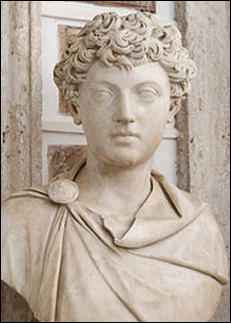
On this day in 1649 Bulstrode Whitelock wrote about the burial of the executed Robert Lockyer. "About one hundred went before the Corpse, five or six in a file; the Corpse was then brought, with six trumpets sounding a soldier's knell; then the Trooper's horse came, clothed all over in mourning and led by a footman. The corpse was adorned with bundles of Rosemary, one half stained in blood; and the Sword of the deceased along with them. Some thousands followed in rank and file: all had sea-green-and-black Ribbon tied on their hats, and to their breasts: and the women brought up the rear. At the new Churchyard in Westminster, some thousands more of the better sort met them, who thought not fit to march through the City. Many looked on this funeral as an affront to the Parliament and the Army; others called these people Levellers; but they took no notice of any of them."
Robert Lockyer was born in London in about 1626. On the outbreak of the English Civil War, Lockyer joined the Parliamentary Army (Roundheads) and served as a private trooper. It is believed that he became a Leveller in November 1647, after reading the An Agreement of the People.
Oliver Cromwell made it very clear that he very much opposed to the idea that more people should be allowed to vote in elections and that the Levellers posed a serious threat to the upper classes: "What is the purport of the levelling principle but to make the tenant as liberal a fortune as the landlord. I was by birth a gentleman. You must cut these people in pieces or they will cut you in pieces."
In July, 1648, the Levellers published their own newspaper, Moderate Intelligencer. Edited by Richard Overton it included articles by John Lilburne, John Wildman and William Walwyn. The newspaper controversially encouraged soldiers in the New Model Army to revolt. In March 1649, Lilburne, Wildman, Overton and Walwyn were arrested and charged with advocating communism. After being brought before the Council of State they were sent to the Tower of London.
Levellers in the army continued to protest against the government. The most serious rebellion took place in London. Troops commanded by Colonel Edward Whalley were ordered from the capital to Essex. A group of soldiers led by Robert Lockyer, refused to go and barricaded themselves in The Bull Inn near Bishopsgate, a radical meeting place. A large number of troops were sent to the scene and the men were forced to surrender. The commander-in-chief, General Thomas Fairfax, ordered Lockyer to be executed.
Lockyer's funeral on Sunday 29th April, 1649, proved to be a dramatic reminder of the strength of the Leveller organization in London. "Starting from Smithfield in the afternoon, the procession wound slowly through the heart of the City, and then back to Moorfields for the interment in New Churchyard. Led by six trumpeters, about 4000 people reportedly accompanied the corpse. Many wore ribbons - black for mourning and sea-green to publicize their Leveller allegiance. A company of women brought up the rear, testimony to the active female involvement in the Leveller movement. If the reports can be believed there were more mourners for Trooper Lockyer than there had been for the martyred Colonel Thomas Rainsborough the previous autumn."
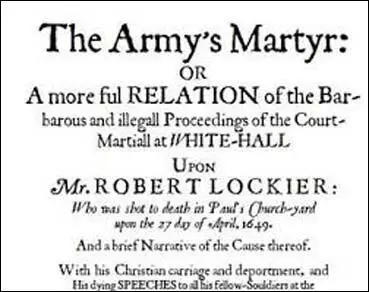
On this day in 1816 Robert Owen gave evidence on child labour to Parliamentary Committee.
Question: At what age to take children into your mills?
Robert Owen: At ten and upwards.
Question: Why do you not employ children at an earlier age?
Robert Owen: Because I consider it to be injurious to the children, and not beneficial to the proprietors.
Question: What reasons have you to suppose it is injurious to the children to be employed at an earlier age?
Robert Owen: Seventeen years ago, a number of individuals, with myself, purchased the New Lanark establishment from Mr. Dale. I found that there were 500 children, who had been taken from poor-houses, chiefly in Edinburgh, and those children were generally from the age of five and six, to seven to eight. The hours at that time were thirteen. Although these children were well fed their limbs were very generally deformed, their growth was stunted, and although one of the best schoolmasters was engaged to instruct these children regularly every night, in general they made very slow progress, even in learning the common alphabet. I came to the conclusion that the children were injured by being taken into the mills at this early age, and employed for so many hours; therefore, as soon as I had it in my power, I adopted regulations to put an end to a system which appeared to me to be so injurious.
Question: Do you give instruction to any part of your population?
Robert Owen: Yes. To the children from three years old upwards, and to every other part of the population that choose to receive it.
Question: If you do not employ children under ten, what would you do with them?
Robert Owen: Instruct them, and give them exercise.
Question: Would not there be a danger of their acquiring, by that time, vicious habits, for want of regular occupation.
Robert Owen: My own experiences leads me to say, that I found quite the reverse, that their habits have been good in proportion to the extent of their instruction.
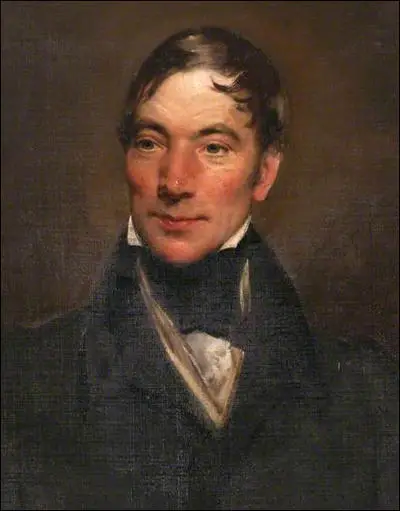
On this day in 1881 Charles Bradlaugh was again refused permission to affirm and is escorted from the House of Commons. Bradlaugh was a member of the Liberal Party and in the 1880 General Election he won the seat of Northampton. At this time the law required in the courts and oath from all witnesses. Bradlaugh saw this an opportunity to draw attention to the fact that "atheists were held to be incapable of taking a meaningful oath, and were therefore treated as outlaws."
Bradlaugh argued that the 1869 Evidence Amendment Act gave him a right he asked for permission to affirm rather than take the oath of allegiance. The Speaker of the House of Commons refused this request and Bradlaugh was expelled from Parliament. William Gladstone supported Bradlaugh's right to affirm, but as he had upset a lot of people with his views on Christianity, the monarchy and birth control and when the issue was put before Parliament, MPs voted to support the Speaker's decision to expel him.
Bradlaugh now mounted a national campaign in favour of atheists being allowed to sit in the House of Commons. Bradlaugh gained some support from some Nonconformists but he was strongly opposed by the Conservative Party and the leaders of the Anglican and Catholic clergy. When Bradlaugh attempted to take his seat in Parliament in June 1880, he was arrested by the Sergeant-at-Arms and imprisoned in the Tower of London. Benjamin Disraeli, leader of the Conservative Party, warned that Bradlaugh would become a martyr and it was decided to release him.
On 26th April, 1881, Charles Bradlaugh was once again refused permission to affirm. William Gladstone promised to bring in legislation to enable Bradlaugh to do this, but this would take time. Bradlaugh was unwilling to wait and when he attempted to take his seat on 2nd August he was once forcibly removed from the House of Commons. Bradlaugh and his supporters organised a national petition and on 7th February, 1882, he presented a list of 241,970 signatures calling for him to be allowed to take his seat. However, when he tried to take the Parliamentary oath, he was once again removed from Parliament.
The authorities attempted to obstruct the activities of Charles Bradlaugh and other freethinkers in the National Secular Society. Pamphlets on religion were seized by the Post Office and on several occasions they were excluded from using public buildings for their meetings. In 1882 the staff of the journal, The Freethinker, were prosecuted for blasphemy, and two of them were found guilty and sent to prison.
Gladstone's Affirmation Bill was discussed by Parliament in the spring of 1883. The Archbishop of Canterbury and Cardinal Manning, head of the Catholic Church, argued against the right of atheists to be MPs and when the vote was taken in May 1883, the Affirmation Bill was defeated. In 1884 Bradlaugh was once again elected to represent Northampton in the House of Commons. He took his seat and voted three times before he was excluded. He was later fined £1,500 for voting illegally.
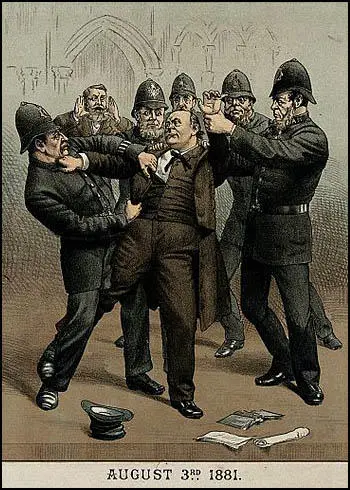
On this day in 1896 German war ace Ernst Udet was born in Frankfurt, Germany. He joined the German Army Air Service in 1915. Flying a Fokker D-III , he scored his first victory on 18th March 1916 in a lone attack on 22 French aircraft. By the end of the First World War Udet had 62 victories. This made him the second highest German war ace of the war.
After the war Udet appeared with Leni Riefenstahl in the film SOS Eisberg. He was also active in the Richthofen Veterans' Association and caused great controversy when he campaigned to have Hermann Goering rejected for for making false claims of air victories during the First World War.
Udet joined the Luftwaffe in June 1935 as a colonel and a year later was appointed head of the Technical Office of the Air Ministry. In this post Udet was responsible for the introduction of the Junkers Stuka and the Messerschmitt Bf109.
During the Second World War he rose to the rank of colonel general and Director of Air Armaments. In 1940 pilots began to complain that the Spitfire was superior to German aircraft. Later Adolf Hitler and Hermann Goering both accused him of being responsible for the defeat of the Luftwaffe during the Battle of Britain. He was also criticized for neglecting the development of new heavy bombers.
Udet became depressed by the performance of the Luftwaffe during Operation Barbarossa and the decision by Erhard Miltch to overrule his plans to develop the Focke Wulf FW 190. On 17th November, 1941, Udet shot himself in the head while on the phone to his mistress.
Adolf Hitler was embarrassed by Udet's death and the Nazi Government issued a statement that Udet had been accidentally killed while testing out a new weapon. The award-winning play, The Devil's General by Carl Zuckmayer, was based on Udet's life.
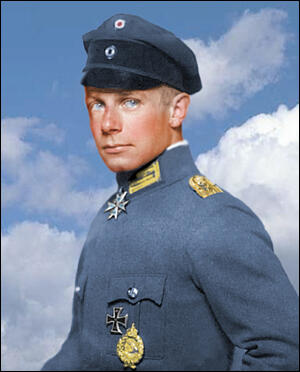
On this day in 1905 Lily Parr was born in St Helens. Her brother was a keen sportsman and he taught her how to play football and rugby. Barbara Jacobs has pointed out in The Dick, Kerr's Ladies (2004): "She (Lily Parr) was as adept at rugby as she was at football, spending hours on her own perfecting the technique of the power kick. She'd sorted that out by the time she was thirteen and in football could score from any place on the pitch, or in rugby kick the finest penalty or drop goal. A left-footer, her ability was natural, magic, but honed by her refusal to conform to the art of being a woman. She wasn't having any of it."
In 1919, the 14 year old Parr started playing football for the St Helens Ladies football team. Her second game was against Dick Kerr Ladies. St Helens lost 6-1. Alfred Frankland, the manager of the team from Preston, was very impressed with the performances of Lily Parr and her team-mate, Alice Woods. After the game Frankland asked the two women to join his team. He also offered to arrange for them to live in Preston. Lily agreed to live in the home of fellow player, Alice Norris.
Frankland agreed to pay Lily 10 shillings every time she played for the team. This worked out at about £100 in today's money. Lily was a great success and in her first season scored 43 goals for the club. Gail Newsham wrote in her book on the team, In a League of their Own (1994) about Lily: "Standing almost six feet tall, with jet black hair, her power and skill was admired and feared, wherever she played. She was an extremely unselfish player who could pin-point a pass with amazing accuracy and was also a marvellous ball player. And she was probably responsible in one way or another, for most of the goals that were scored by the team".
In 1920 a local newspaper wrote about this talented 14 year old: "There is probably no greater football prodigy in the whole country. Not only has she speed and excellent ball control, but her admirable physique enables her to brush off challenges from defenders who tackle her. She amazes the crowd where ever she goes by the way she swings the ball clean across the goalmouth to the opposite wing."
One of her team-mates, Joan Whalley, remarked on Parr's sense of humour: "When the older players were getting ready for a match, there were elastic stockings going on knee's and strapping up of ankles, there were bandages here there and everywhere. Then Parr walked in, and she stood looking around at them all and said, "well, I don't know about Dick Kerr Ladies football team, it looks like a bloody trip to Lourdes to me!"
In 1920 Alfred Frankland arranged for the Federation des Societies Feminine Sportives de France to send a team to tour England. Frankland believed that his team was good enough to represent England against a French national team. Four matches were arranged to be played at Preston, Stockport, Manchester and London. The matches were played on behalf of the National Association of Discharged and Disabled Soldiers and Sailors.
A crowd of 25,000 people turned up to the home ground of Preston North End to see the first unofficial international between England and France. England won the game 2-0 with Florrie Redford and Jennie Harris scoring the goals.
The two teams travelled to Stockport by charabanc. This time England won 5-2. The third game was played at Hyde Road, Manchester. Over 12,000 spectators saw France obtain a 1-1 draw. Madame Milliat reported that the first three games had raised £2,766 for the ex-servicemens fund.
The final game took place at Stamford Bridge, the home of Chelsea Football Club. A crowd of 10,000 saw the French Ladies win 2-1. However, the English Ladies had the excuse of playing most of the game with only ten players as Jennie Harris suffered a bad injury soon after the game started. This game caused a stir in the media when the two captains, Alice Kell and Madeline Bracquemond, kissed each other at the end of the match.
On 28th October, 1920. Alfred Frankland took his team to tour France. On Sunday 31st October, 22,000 people watched the two sides draw 1-1 in Paris. However, the game ended five minutes early when a large section of the crowd invaded the pitch after disputing the decision by the French referee to award a corner-kick to the English side. After the game Alice Kell said the French ladies were much better playing on their home ground.
The next game was played in Roubaix. England won 2-0 in front of 16,000 spectators, a record attendance for the ground. Florrie Redford scored both the goals. England won the next game at Havre, 6-0. As with all the games, the visitors placed a wreath in memory of allied soldiers who had been killed during the First World War.
The final game was in Rouen. The English team won 2-0 in front of a crowd of 14,000. When the team arrived back in Preston on 9th November, 1920, they had travelled over 2,000 miles. As captain of the team, Alice Kell made a speech where she said: "If the matches with the French Ladies serve no other purpose, I feel that they will have done more to cement the good feeling between the two nations than anything which has occurred during the last 50 years."
Soon after arriving back in Preston, Alfred Frankland was informed that the local charity for Unemployed Ex- Servicemen was in great need for money to buy food for former soldiers for Christmas. Frankland decided to arrange a game at between Dick Kerr Ladies and a team made up of the rest of England. Deepdale, the home of Preston North End was the venue. To maximize the crowd, it was decided to make it a night game. Permission was granted by the Secretary of State for War, Winston Churchill, for two anti-aircraft searchlights, generation equipment and forty carbide flares, to be used to floodlight the game.
Over 12,000 people came to watch the match that took place on 16th December, 1920. It was also filmed by Pathe News. Bob Holmes, a member of the Preston team that won the first Football League title in 1888-89, had the responsibility of providing whitewashed balls at regular intervals. Although one of the searchlights went out briefly on two occasions, the players coped well with the conditions. Dick Kerr Ladies showed they were the best woman's team in England by winning 4-0. Jennie Harris scored twice in the first half and Florrie Redford and Minnie Lyons added further goals before the end of the game. A local newspaper described the ball control of Harris as "almost weird". He added "she controlled the ball like a veteran league forward, swerved, beat her opponents with the greatest of ease, and passed with judgment and discretion". As a result of this game, the Unemployed Ex Servicemens Distress Fund received over £600 to help the people of Preston. This was equivalent to £125,000 in today's money.
On 26th December, 1920, Dick Kerr Ladies played the second best women's team in England, St Helens Ladies, at Goodison Park, the home ground of Everton. The plan was to raise money for the Unemployed Ex Servicemens Distress Fund in Liverpool. Over 53,000 people watched the game with an estimated 14,000 disappointed fans locked outside. It was the largest crowd that had ever watched a woman's game in England.
Florrie Redford, Dick Kerr Ladies' star striker, missed her train to Liverpool and was unavailable for selection. In the first half, Jennie Harris gave Dick Keer Ladies a 1-0 lead. However, the team was missing Redford and so the captain and right back, Alice Kell, decided to play centre forward. It was a shrewd move and Kell scored a second-half hat trick which enabled her side to beat St Helens Ladies 4-0.
The game at Goodison Park raised £3,115 (£623,000 in today's money). Two weeks later the Dick Kerr Ladies played a game at Old Trafford, the home of Manchester United, in order to raise money for ex-servicemen in Manchester. Over 35,000 people watched the game and £1,962 (£392,000) was raised for charity.
In 1921 the Dick Kerr Ladies team was in such demand that Alfred Frankland had to refuse 120 invitations from all over Britain. The still played 67 games that year in front of 900,000 people. It has to be remembered that all the players had full-time jobs and the games had to be played on Saturday or weekday evenings. As Alice Norris pointed out: "It was sometimes hard work when we played a match during the week because we would have to work in the morning, travel to play the match, then travel home again and be up early for work the next day."
On 14th February, 1921, 25,000 people watched Dick Kerr Ladies beat the Best of Britain, 9-1. Lily Parr (5), Florrie Redford (2) and Jennie Harris (2) got the goals. Representing their country, the Preston team beat the French national side 5-1 in front of 15,000 people at Longton. Parr scored all five goals.
The Dick Kerr Ladies did not only raise money for Unemployed Ex Servicemens Distress Fund. They also helped local workers who were in financial difficulty. The mining industry in particular suffered a major recession after the war. In March, 1921, the mine-owners announced a further 50% reduction in miner's wages. When the miners refused to accept this pay-cut, they were locked out from their jobs. On April 1 and, immediately on the heels of this provocation, the government put into force its Emergency Powers Act, drafting soldiers into the coalfield.
The government and the mine-owners attempted to starve the miners into submission. Several members of the Dick Kerr team came from mining areas like St. Helens and held strong opinions on this issue and games were played to raise money for the families of those men locked out of employment. As Barbara Jacobs pointed out in The Dick, Kerr's Ladies: "Women's football had come to be associated with charity, and had its own credibility. Now it was used as a tool to help the Labour Movement and the trade unions. It had, it could be said, become a politically dangerous sport, to those who felt the trade unions to be their enemies.... Women went out to support their menfolk, a Lancashire tradition, was causing ripples in a society which wanted women to revert to their prewar roles as set down by their masters, of keeping their place, that place being in the home and kitchen. Lancashire lasses were upsetting the social order. It wasn't acceptable."
The 1921 Miners Lock-Out caused considerable suffering in mining areas in Wales and Scotland. This was reflected by games played in Cardiff (18,000), Swansea (25,000) and Kilmarnock (15,000). Dick Kerr Ladies represented England beat Wales on two successive Saturdays. They also beat Scotland on 16th April, 1921.
The Football Association was appalled by what they considered to be women's involvement in national politics. It now began a propaganda campaign against women's football. A new rule was introduced that stated no football club in the FA should allow their ground to be used for women's football unless it was prepared to handle all the cash transactions and do the full accounting. This was an attempt to smear Alfred Frankland with financial irregularities.
On 5th December 1921, the Football Association issued the following statement: "Complaints having been made as to football being played by women, the Council feel impelled to express their strong opinion that the game of football is quite unsuitable for females and ought not to be encouraged. Complaints have been made as to the conditions under which some of these matches have been arranged and played, and the appropriation of the receipts to other than Charitable objects. The Council are further of the opinion that an excessive proportion of the receipts are absorbed in expenses and an inadequate percentage devoted to Charitable objects. For these reasons the Council requests the clubs belonging to the Association refuse the use of their grounds for such matches."
This measure removed the ability of women to raise significant sums of money for charity as they were now barred from playing at all the major venues. The Football Association also announced that members were not allowed to referee or act as linesman at any women's football match.
The Dick Kerr Ladies team were shocked by this decision. Alice Kell, the captain, spoke for the other women when she said: "We play for the love of the game and we are determined to carry on. It is impossible for the working girls to afford to leave work to play matches all over the country and be the losers. I see no reason why we should not be recompensated for loss of time at work. No one ever receives more than 10 shillings per day."
Alice Norris pointed out that the women were determined to resist attempts to stop them playing football: "We just took it all in our stride but it was a terrible shock when the FA stopped us from playing on their grounds. We were all very upset but we ignored them when they said that football wasn't a suitable game for ladies to play."
As Gail Newsham argued In a League of their Own: "So, that was that, the axe had fallen, and despite all the ladies denials and assurances regarding finances, and their willingness to play under any conditions that the FA laid down, the decision was irreversible. The chauvinists, the medical 'experts' and the anti women's football lobby had won - their threatened male bastion was now safe."
Alfred Frankland responded to the action taken by the Football Association with the claim: "The team will continue to play, if the organisers of charity matches will provide grounds, even if we have to play on ploughed fields."
Frankland now decided to take his team on a tour of Canada and the United States. The team included Lily Parr, Jennie Harris, Daisy Clayton, Alice Kell, Florrie Redford, Florrie Haslam, Alice Woods, Jessie Walmsley, Molly Walker, Carmen Pomies, Lily Lee, Alice Mills, Annie Crozier, May Graham, Lily Stanley and R. J. Garrier. Their regular goalkeeper, Peggy Mason, was unable to go due to the recent death of her mother.
When the Dick Kerr Ladies arrived in Quebec on 22nd December, 1922, they discovered that the Dominion Football Association had banned them from playing against Canadian teams. They were accepted in the United States, and even though they were sometimes forced to play against men, they lost only 3 out of 9 games. They visited Boston, Baltimore, St. Louis, Washington, Detroit, Chicago and Philadelphia during their tour of America.
Florrie Redford was the leading scorer on the tour but Lily Parr was considered the star player and American newspapers reported that she was the "most brilliant female player in the world". One member of the team, Alice Mills, met her future husband at one of the games, and would later return to marry him and become an American citizen.
In Philadelphia four members of the team, Lily Parr, Jennie Harris, Florrie Haslam and Molly Walker, met the American Women's Olympic team in a relay race of about a quarter of a mile. Even though their fastest runner, Alice Woods, was unavailable through illness, the Preston ladies still won the race.
Dick Kerr Ladies continued to play charity games in England but denied access by the Football Association to the large venues, the money raised was disappointing when compared to the years immediately following the First World War. In 1923 the French Ladies came over for their annual tour of England. They played against Dick Kerr Ladies at Cardiff Arms Park. Part of the proceeds were for the Rheims Cathedral Fund in France.
Dick, Kerr Engineering was eventually taken over by English Electric. Although they allowed the team to play on Ashton Park, it refused to subsidize the football team. Alfred Frankland was also told that he would no longer be given time off to run the team that was now known as the Preston Ladies.
Frankland decided to leave English Electric and open a shop with his wife in Sharoe Green Lane in Preston where they sold fish and greengroceries. He continued to manage Preston Ladies with great success.
Some of the players also lost their jobs with English Electric. Over the years Frankland had raised considerable sums of money for Whittingham Hospital and Lunatic Asylum. The hospital was always willing to employ and provide accommodation for Frankland's players. This included Lily Parr, Florrie Redford, Jessie Walmsley and Lily Martin. In 1923 Frankland persuaded Lizzy Ashcroft and Lydia Ackers, two of St Helens best players, to join Preston Ladies. Both women went to work for Whittingham Hospital.
While working at the hospital Lily Parr met her partner Mary and together they bought a house in Preston. Lily continued to work and eventually became a Ward Sister at the hospital.
During the General Strike English Electric stopped Preston Ladies from playing on Ashton Park. Alice Norris pointed out: "It was our training night and we were told not to go up to Ashton Park anymore. Something must have gone wrong between him (Frankland) and the firm."
Despite the lack of sponsorship, Preston Ladies continued to be the best team in England. In 1927 they beat their rivals for the title, Blackpool Ladies, 11-2. Lily Parr, Florrie Redford and Jennie Harris all scored goals in the game.
Alice Woods stopped playing for Preston Ladies when she married Herbert Stanley in September, 1928. Other players like Alice Kell got married and gave up football. Florrie Redford emigrated to Canada in 1930 to pursue her career as a nurse whereas Carmen Pomies returned to France. Jennie Harris kept playing until the mid-1930s.
Lily Parr, who never got married, continued to play football for Preston Ladies. Lydia Ackers, who played for many years with Parr argued that: "I have never seen any woman, nor many a man, kick a ball like she could. Everybody was amazed when they saw her power, you would never believe it."
Joan Whalley was another one who played in the same team as Lily Parr later wrote: "She had a kick like a mule. she was the only person I knew who could lift a dead ball, the old heavy leather ball, from the left wing over to me on the right and nearly knock me out with the force of the shot.... When she took a left corner kick, it came over like a bullet, and if you ever hit one of those with your head... I only ever did it once and the laces on the ball left their impression on my forehead and cut it open."
Some shrewd observers believed she was good enough to play for a club in the Football League. Bobby Walker, a Scottish international player, belied that she was the "best natural timer of a football I have ever seen." Alfred Frankland went further describing her as the "best outside left playing in the world today."
On 8th September, 1937, Preston Ladies beat Edinburgh Ladies to win the "championship of Great Britain and the World". Preston won 5-1 with Lily Parr scoring one of the goals. Joan Whalley, who was only 15, also scored. A World Championship Victory Dinner was held at Booths Cafe in Preston.
Alfred Frankland made a speech where he claimed: "Since our inception we have played 437 matches, won 424, lost 7 and drawn 6, scored 2,863 goals and had only 207 scored against. We have raised over £100,000 in this country and in foreign lands for charity. We have won 14 silver cups, 5 of them outright, and hold a trophy awarded for the most meritorious assistance given to ex-servicemen."
Preston Ladies only played a small number of games during the Second World War. The rationing of petrol made it difficult to travel to games. Alfred Frankland also worked as a ARP Warden during the war and did not have the time to organize games.
In 1946 Lily Parr was made captain in recognition of 26 years service. She had only missed 5 games since joining the team in 1920. The local newspaper reported that she had scored 967 goals out of the teams total score of 3,022.
The Football Association refused to lift its ban on women players. In 1947 the Kent County Football Association suspended a referee because he was working as a manager/trainer with Kent Ladies Football Club. It justified its decision with the comment that "women's football brings the game into disrepute".
In 1950 Alfred Frankland calculated that since 1917 Preston Ladies had played 643 games. Of these, they had only lost 9 games. He also claimed that that the team had raised £140,000 for charity.
Lily Parr was aged 45 when she played her last game on 12th August, 1950. She scored a goal in an 11-1 victory over Scotland. During her long career she had scored more than 900 goals. Preston Ladies folded in 1965. Five years later the Football Association agreed to lift its ban on women's players.
Lily Parr retired from the hospital in the early 1960s. A life-long smoker she developed cancer and in 1967 had a double mastectomy. Lily commented: "It's taken me 62 years to grow these, now they have taken them off me!" She refused to give up smoking and asked her friends to bring in packets of Woodbines while she was in hospital.
Lily Parr died of cancer in her home in St Helens on 24th May 1978. In 1992, Lily Parr, England's best ever woman player, was inducted into the Football Hall of Fame at the National Football Museum in Preston.
I am indebted to the research carried out by Barbara Jacobs (The Dick, Kerr's Ladies) and Gail Newsham (In a League of their Own) for the information in this article.
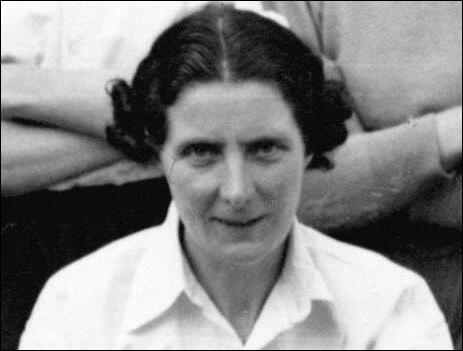
On this day in 1926 Kingsley Martin comments on the General Strike. "Arthur Cook made a most interesting study - worn-out, strung on wires, carried in the rush of the tidal wave, afraid of the struggle, afraid, above all, though, of betraying his cause and showing signs of weakness. He'll break down for certain, but I fear not in time. He's not big enough, and in an awful muddle about everything. Poor devil and poor England. A man more unable to conduct a negotiation I never saw. Many Trade Union leaders are letting the men down; he won't, but he'll lose. And Socialism in England will be right back again."
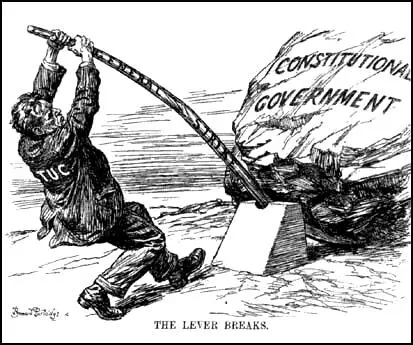
On this day in 1933 Nazi Germany limits the number of Jewish students in schools and universities. The social historian, Richard Grunberger, has argued in A Social History of the Third Reich (1971) that when Adolf Hitler came to power in 1933 he inherited a very conservative educational system: "The influence of Germany's educational system on her national fortunes invites comparison with that of the playing-fields of Eton on the Battle of Waterloo. It was in the classrooms that the foundations were laid for Bismarck's victories over Danes, Austrians and French abroad and over German parliamentarians at home."
Hitler held very strong opinions on education. The only teacher he liked at secondary school was Leopold Potsch, his history master. Potsch, like many people living in Upper Austria, was a German Nationalist. Potsch told Hitler and his fellow pupils of the German victories over France in 1870 and 1871 and attacked the Austrians for not becoming involved in these triumphs. Otto von Bismarck, the first chancellor of the German Empire, was one of Hitler's early historical heroes.
Hitler wrote in Mein Kampf (1925): "Dr. Leopold Potsch... used our budding nationalistic fanaticism as a means of educating us, frequently appealing to our sense of national honor. By this alone he was able to discipline us little ruffians more easily than would have been possible by any other means. This teacher made history my favorite subject. And indeed, though he had no such intention, it was then that I became a little revolutionary. For who could have studied German history under such a teacher without becoming an enemy of the state which, through its ruling house, exerted so disastrous an influence on the destinies of the nation? And who could retain his loyalty to a dynasty which in past and present betrayed the needs of the German people again and again for shameless private advantage?"
Hitler immediately made changes to the school curriculum. Education in "racial awareness" began at school and children were constantly reminded of their racial duties to the "national community". Biology, along with political education, became compulsory. Children learnt about "worthy" and "unworthy" races, about breeding and hereditary disease. "They measured their heads with tape measures, checked the colour of their eyes and texture of their hair against charts of Aryan or Nordic types, and constructed their own family trees to establish their biological, not historical, ancestry.... They also expanded on the racial inferiority of the Jews".
As Louis L. Snyder has pointed out: "There were to be two basic educational ideas in his ideal state. First, there must be burnt into the heart and brains of youth the sense of race. Second, German youth must be made ready for war, educated for victory or death. The ultimate purpose of education was to fashion citizens conscious of the glory of country and filled with fanatical devotion to the national cause."
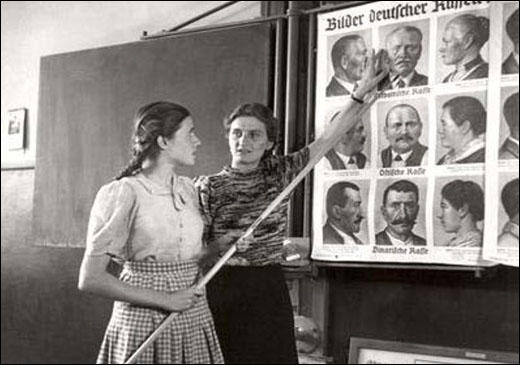
On this day in 1937, Guernica was bombed by the German Condor Legion. On the outbreak of the Spanish Civil War Guernica had a population of about 7,000 people. As it was a market day the town was crowded. The town was first struck by explosive bombs and then by incendiaries. As people fled from their homes they were machine-gunned by fighter planes. The three hour raid completely destroyed the town. It is estimated that 1,685 people were killed and 900 injured in the attack.
General Francisco Franco denied that he had nothing to do with the raid and claimed that the town had been dynamited and then burnt by Anarchist Brigades. After the war a telegram sent from Franco's headquarters was discovered and revealled that he had asked the German Condor Legion to carry out the attack on Guernica. It is believed that the attack was an attempt to demoralize the Basque people.
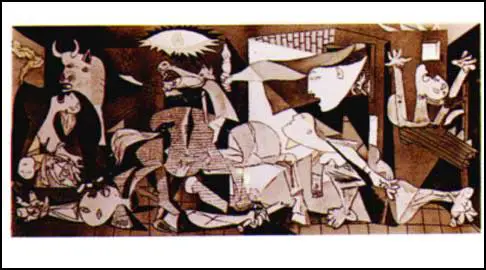
On this day in 1945 Ann Stringer writes an article about the Red Army crossing the Elbe River.
"The Elbe River is swarming with Russian soldiers, stripped to their shorts. They are swimming over to greet us. The Germans blew all the bridges across the Elbe, but there is a small fleet of shaky boats and canoes. I decided to cross the river in one of them and visit the Russians.
As the Russians on the eastern bank saw us coming in our canoe they rushed down to the river bank through the tall, wet grass and began yelling greetings. They helped us drag the canoe up on the bank, and then they all stood rigidly at attention for a moment. One by one they stepped forward, saluted, shook hands and stepped back into line.
Then Lt. Grigori Otenchuku, a veteran of Stalingrad, stepped forward to make a formal speech in behalf of the Russians. "A few months ago German soldiers were nearly in Stalingrad," he said. "Now Russian soldiers are in Berlin and Russian soldiers are here - all the way across Germany - with their American Allies."
Our party consisted of Lt. Myril Mayer of Wood River and Lt. Raymond Worth of Galveston. The Russian soldiers insisted that we meet the commander of their regiment, so we started off. I noticed that almost all of our escort wore at least one brilliantly colored medal on their greenish tunics.
We were introduced to the commander, a quiet, stocky man with jet black hair. We gave the Russians our autographs. They gave us theirs. The commander invited us to lunch. He said I was the first American woman he and his troops had ever seen, and he seated me in the place of honor on his right at the luncheon."
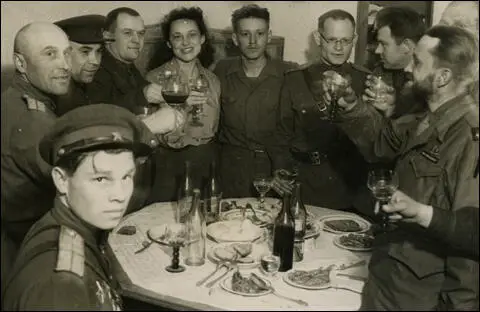
On this day in 1968 German artist John Heartfield died in Berlin.
Helmut Herzfeld was born in Berlin, Germany on 19th June, 1891. His father, Franz Held, was a socialist writer and his mother, Alice Stolzenberg, was a textile worker and a trade union activist. As a result of their politics the family was forced to flee to Switzerland in 1896.
After leaving school at fourteen Herzfeld worked for a bookseller, Heinrich Heuss, in Wiesbaden. In 1907 he became an assistant to the painter, Hermann Bouffier, and two years later became a student at the School of Applied Arts in Munich. In 1912 Herzfeld started work as a designer in Mannheim for a year before moving to Berlin to study under Ernst Neumann at the Arts and Crafts School.
Helmut Herzfeld was drafted into the German Army in 1915 but succeeds in evading military service. (3) Karl Liebknecht, the leader of the Spartacus League, a secret organization, published a pamphlet, The Main Enemy Is At Home! He argued: "The main enemy of the German people is in Germany: German imperialism, the German war party, German secret diplomacy. This enemy at home must be fought by the German people in a political struggle, cooperating with the proletariat of other countries whose struggle is against their own imperialists. We think as one with the German people – we have nothing in common with the German Tirpitzes and Falkenhayns, with the German government of political oppression and social enslavement. Nothing for them, everything for the German people. Everything for the international proletariat, for the sake of the German proletariat and downtrodden humanity."
On 1st May, 1916, the Spartacus League decided to come out into the open and organized a demonstration against the First World War in Berlin. Helmut Herzfeld was in the crowd that day and heard Liebknecht and Rosa Luxemburg call for everyone to resist Germany's involvement in the war. Several of its leaders, including Liebknecht and Luxemburg were arrested and imprisoned. Wieland Herzfelde, said that the speeches at the rally had a great influence on his brother. It was at this point he decided to dedicate his art to politics. Wieland later wrote: "We are the soldiers of peace. No nation and no race is our enemy." A pacifist and Marxist, Herzfeld, changed his name to John Heartfield in 1916 in "protest against German nationalistic fervour".
Heartfield began contributing work to Die Neue Jugend, an arts journal published by his brother. His friend, George Grosz, who worked with him at the journal, later recalled how John Heartfield "developed a new very amusing style of using collage and bold typography". Grosz helped him develop what became known as photomontage (the production of pictures by rearranging selected details of photographs to form a new and convincing unity). We... invented photomontage in my South End studio at five o'clock on a May morning in 1916, neither of us had any inkling of its great possibilities, nor of the thorny yet successful road it was to take. As so often happens in life, we had stumbled across a vein of gold without knowing it."
In 1918 Heartfield, Grosz and Erwin Piscator joined the newly formed German Communist Party (KPD) and over the next fifteen years produced designs and posters for the organization. He participated in the First International Dada Fair of 1920. It is claimed that Heartfield had a major influence on the German Dada group that included Otto Dix, Max Ernst, Raoul Hausmann and Kurt Schwitters.
Sergei Tretyakov was another artist linked to the Dada group. "Heartfield's first Dadaist photomontages are still marked by their abstract nature. Scraps of photograph and printed text are arranged not so much according to meaning but according to the aesthetic mood of the artist. The Dadaist period in Heartfield's work did not continue for long. He soon ceased to waste his artistic talents in abstract fireworks. His works became aimed shots... Soon no line could be drawn between his montages and his party work."
Over the next few years Heartfield produced posters for the KPD. However, to earn a living he worked briefly as a set designer for Max Reinhardt and more consistently for the revolutionary theatre of Erwin Piscator. He also designed book jackets for the left-wing publishers, Malik Verlag. In 1923 Heartfield became editor of the satirical magazine, Der Knöppel.
Bertolt Brecht first met John Heartfield in 1924. He pointed out that he soon became one of the most important European artists. "He works in a field that he created himself, the field of photomontage. Through this new form of art he exercises social criticism. Steadfastly on the side of the working class, he unmasked the forces of the Weimar Republic driving toward war." Heartfield wrote: "Art and agitation are mutually exclusive".
Wieland Herzfelde argued "he consciously placed photography in the service of political agitation". (15) In 1928 he created The Face of Fascism, a montage that dealt with the rule of Benito Mussolini which spread all over Europe with tremendous force. "A skull-like face of Mussolini is eloquently surrounded by his corrupt backers and his dead victims".
Heiri Strub has pointed out that Heartfield made the decision to use his art for political causes. "Heartfield always considered his photomontages as artistic achievements. He took in stride the fact that he was not recognized by contemporary art critics. The works he created for dissemination in huge editions had no value in the art market. Directing his political charges at the masses, he could scarcely count on a sympathetic reaction from bourgeois art collectors. The worker, however, for whom he intended his photomontages, understood their revolutionary content, but assigned no artistic value judgment to them."
Heartfield began working for the socialist magazine, Arbeiter-Illustrierte-Zeitung (AIG) in 1929. During this period it became the most widely socialist pictorial newspaper in Germany. Circulation reached 350,000 in 1930. Zbyněk Zeman has pointed out that at this stage Heartfield concentrated his attack on "Prussian militarism and the large-scale industries and industrialists who supplied it with arms".
The German novelist, Heinrich Mann, was one of those who saw the significance of the magazine: "The Arbeiter-Illustrierte-Zeitung is one of the best of current picture newspapers. It is full in its coverage, technically good, and, above all, unusual and new... Aspects of daily life are seen here through the eyes of the worker, and it is time that this happened. The pictures express complaints and threats reflecting the attitude of the proletariat - but at the same time this proves their self-confidence and their energetic activity to help themselves. The self-confidence of the proletariat in this weary part of the world is most heartening."
Heiri Strub worked with Heartfield at the magazine. "Heartfield's high demands of quality made collaboration with him difficult. His long-time colleague, the photographer Janos Reismann, related how Heartfield constantly demanded new pictures until he saw his idea realized... With photographic tricks and painting Heartfield arranged the parts of the photo to fit together seamlessly. With extraordinary care he devised his adhesive picture, so that after final retouching it went straight to the printer. Since the AIZ was produced using the highly sensitive copperplate photogravure method, errors were as evident as the artist's real intention. Heartfield's respect for the skills of others was so great that he himself did not do the photography, and he left the retouching to others, but always under his stringent supervision."
Louis Aragon has argued: "John Heartfield is one of those who expressed the strongest doubts about painting, especially its technical aspects... As we know, Cubism was a reaction of painters to the invention of photography. The photograph and the cinema made it seem childish to them to strive for verisimilitude. By means of these new technical accomplishments they created a conception of art which led some to attack naturalism and others to a new definition of reality. With Leger it led to decorative art, with Mondrian to abstraction, with Picabia to the organization of mundane evening entertainment. But toward the end of the war, several men in Germany (Grosz, Heartfield, Ernst) were led through the critique of painting to a spirit which was quite different from the Cubists, who pasted a piece of newspaper on a matchbox in the middle of the picture to give them a foothold in reality. For them the photograph stood as a challenge to painting and was released from its imitative function and used for their own poetic purpose."
John Heartfield's main target in the early 1930s was Adolf Hitler and his Nazi Party. His work often appeared on the front cover of AIG. In 1930 the magazine published twelve of his photomontages. This included one that showed Fritz Thyssen, the owner of United Steelworks, a company that controlled more that 75 per cent of Germany's ore reserves and employed 200,000 people. In the photomontage, Thyssen is shown working Hitler as a puppet.
In 1932 Heartfield produced 18 photomontages for AIG. The most famous of these appeared just before the November 1932 General Election. Hitler is showed standing in front of a large man who represents big business. The man is handing over money to Hitler. Printed underneath are the words: "Motto: Millions stand behind me! A little man asks for gifts". Heartfield's friend, Oskar Maria Graf, commented, that all his work was now politically motivated, "the intolerable aspect of events is the motor of his art".
Richard Carline was an English artist who met him during this period: "Slight and little more than five feet tall, Heartfield displayed the unmistakable traits of genius - single-minded and purposeful. With his intense, unpretentious, and uninhibited personality, he warmed toward everyone he met without regard for class or background. He would talk to animals as if they were humans."
In the election in November 1932 the Nazi Party won 230 seats, making it the largest party in the Reichstag. The German National Party, won nearly a million additional votes. However the German Social Democrat Party (133) and the German Communist Party (89) still had the support of the urban working class and Hitler was deprived of an overall majority in parliament. In numerical terms, the socialist parties obtained 13,228,000 votes compared to the 14,696,000 votes recorded for the Nazis and the German Nationalists.
Soon after Hitler became chancellor in January 1933 he announced new elections. Hermann Goering called a meeting of important industrialists where he told them that the election would be the last in Germany for a very long time. He explained that Hitler "disapproved of trade unions and workers' interference in the freedom of owners and managers to run their concerns." Goering added that the NSDAP would need a considerable amount of of money to ensure victory. Those present responded by donating 3 million Reichmarks. As Joseph Goebbels wrote in his diary after the meeting: "Radio and press are at our disposal. Even money is not lacking this time."
On 27th February, 1933, the Reichstag caught fire. When they police arrived they found Marinus van der Lubbe on the premises. After being tortured by the Gestapo he confessed to starting the Reichstag Fire. However he denied that he was part of a Communist conspiracy. Hermann Goering refused to believe him and he ordered the arrest of several leaders of the German Communist Party (KPD).
When Hitler heard the news about the fire he gave orders that all leaders of the German Communist Party should "be hanged that very night." Paul von Hindenburg vetoed this decision but did agree that Hitler should take "dictatorial powers". KPD candidates in the election were arrested and Hermann Goering announced that the Nazi Party planned "to exterminate" German communists. John Heartfield responded to these events by producing Goering the Executioner of the Third Reich. It shows the "human bloodhound with his axe standing in front of the burning parliament."
Behind the scenes Goering, who was minister of the interior in Hitler's government, was busily sacking senior police officers and replacing them with Nazi supporters. These men were later to become known as the Gestapo. Goering also recruited 50,000 members of the Sturm Abteilung (SA) to work as police auxiliaries. Goering then raided the headquarters of the German Communist Party (KPD) in Berlin and claimed that he had uncovered a plot to overthrow the government. Leaders of the KPD were arrested but no evidence was ever produced to support Goering's accusations. He also announced he had discovered a communist plot to poison German milk supplies.
Thousands of members of the Social Democrat Party and trade union activists were arrested and sent to recently opened concentration camps. Left-wing election meetings were broken up by the Sturm Abteilung (SA) and several candidates were murdered. Newspapers that supported these political parties were closed down during the election. Although it was extremely difficult for the opposition parties to campaign properly, Hitler and the Nazi party still failed to win an overall victory in the election on 5th March, 1933. The Nazi Party received 43.9% of the vote and only 288 seats out of the available 647. The increase in the Nazi vote had mainly come from the Catholic rural areas who feared the possibility of an atheistic Communist government.
Adolf Hitler ordered the arrests of all those artists that had criticized him during his rise to power. On 16th April, 1933, members of the Sturmabteilung (SA) arrived at Heartfield's apartment. Heartfield had been warned about what was going to happen and he managed to flee to Prague. This now became the place where AIG was published. That year Heartfield produced 35 front-covers. However, it was very difficult to smuggle the magazine back to Germany and circulation dropped dramatically from the 500,000 copies that were being sold before Hitler took power.
All forms of mass communication were now controlled in Nazi Germany. The man in overall charge was Dr. Joseph Goebbels, the Minister of Propaganda. Lists were drawn up of books the Nazis believed contained "un-German" ideas and then all available copies were publically destroyed. The Nazis were especially hostile to works produced by left-wing writers like Bertolt Brecht and Ernst Toller.
John Heartfield was especially upset by the passing of the Enabling Bill. This banned the German Communist Party and the Social Democratic Party from taking part in future election campaigns. This was followed by Nazi officials being put in charge of all local government in the provinces (7th April), trades unions being abolished, their funds taken and their leaders put in prison (2nd May), and a law passed making the Nazi Party the only legal political party in Germany (14th July). This situation motivated Heartfield to produce the Executioner and Justice on 30th November 1933.
Adolf Hitler became increasingly annoyed with John Heartfield's photomontages published in Prague (35 in 1933) and he told the government in Czechoslovakia to ban his work. In May 1934 the authorities agreed to Hitler's demands. This created a great deal of controversy and the French artist, Paul Signac, urged international action. He wrote a letter to Heartfield's supporters in Prague: "My whole life long I have been fighting for the freedom of art... I am prepared to contribute my share in organizing a French exhibition of our friend's works... The club is poised for battle against the freedom of the spirit. Let us unite to defend ourselves."
The French poet, Louis Aragon, argued in Commune Magazine: "John Heartfield today knows how to salute beauty. He knows how to create those images which are the beauty of our rage since they represent the cry of the people - the representation of the people's struggle against the brown hangman with his craw crammed with gold pieces. He knows how to create these realistic images of our life and struggle arresting and gripping for millions of people who themselves are a part of that life and struggle. His art is art in Lenin's sense for it is a weapon in the revolutionary struggle of the proletariat."
Heartfield's friends in Europe helped to get his work published. Several photomontages on the Spanish Civil War were published. This included Madrid 1936, a work of art that dealt with the Siege of Madrid. Another poster, The Mothers to their Sons in Franco's Service, was published in December 1936. On the poster it said: "For what you were hired. Whom you are hounding. So permit us mothers to tell you: We grieve for you, young ones. No, we did not raise you to murder. You are allowing yourselves to be abused. You have been betrayed!"
In October 1937 John Heartfield published Warning. In the photomontage an audience looks at a scene of horror caused by Japanese air raids in Manchuria. "Heartfield's pastiche layers in several rows of faceless male heads, backs towards us, beneath the frontal stare of an on-screen victim in the violent newsreel footage at which they are staring: a Chinese mother holding a bloodied child in outsized close-up." (35) It had the caption: "Today you see a film of war in other countries. But remember, if you don't unite to resist it now, tomorrow it will kill you, too!" It was a prediction that was to come true within two years.
When Adolf Hitler ordered the invasion of Czechoslovakia after the Munich Agreement of 1938 John Heartfield was forced to flee the country. In December he arrived in London. Over the next few months his work appeared in the Reynolds News and Lilliput. He spoke at political rallies, organized anti-Fascist groups, and took part in a successful political cabaret, Four and Twenty Black Sheep. On 23rd September, 1939, Picture Post used one of Heartfield's earlier photomontages, His Majesty Adolf, which showed Hitler wearing the Kaiser's uniform and moustache, on its front-cover.
On the outbreak of the Second World War he was interned with fellow refugees who had suffered under the Nazis and were now dubbed "enemy aliens". He was suffering from poor health and he was eventually released but he was not asked to work for the British government. "His whole ambition was to make people fully aware of the menace of Fascism and to expose the Nazi tyranny through his work as an artist... The powerful contribution he might have made toward the Allied victory through his mastery of satire was not acceptable to the British authorities. They were highly suspicious of art, especially experimental forms of art by a German refugee."
One of John Heartfield most powerful photomontages, This is the Salvation that they Bring!, that had originally been published in protest against the Spanish Civil War, was republished during the Blitz. On the poster it had an extract from an article that appeared in the Nazi Party funded Berlin Journal for Biology and Race Research: "The densely populated sections of cities suffer most acutely in air raids. Since these areas are inhabited for the most part by the ragged proletariat, society will thus be rid of these elements. One-ton bombs not only cause death but also very frequently produce madness. People with weak nerves cannot stand such shocks. That makes it possible for us to find out who the neurotics are. Then the only thing that remains is to sterilize such people. Thereby the purity of the race is guaranteed."
John and his third wife, Gertrud (Tutti) Heartfield, settled in Hampstead. During the war he was an active member of the Artists International Association and contributed to its exhibitions. Heartfield also designed book jackets for the London publisher Lindsay Drummond and Penguin Books.
John Heartfield and his wife moved to Leipzig in East Germany in August 1950. Together with his brother, Wieland Herzfelde, he worked for publishers and organizations in the GDR. He also designed scenery and posters for the Berliner Ensemble and the Deutsches Theatre. However, as Peter Selz has pointed out, he found it difficult to produce political photomontages. "While he was celebrated as a cultural leader, his chief idiom, photomontage, was still suspect during the 1950s among the more orthodox advocates of socialist realism."
John Heartfield continued to be a peace activist and on 9th June 1967, at the time of an exhibition of his works at the Stockholm Modern Museum, he wrote about the dangers posed by the Vietnam War. "Since we are living in the nuclear age, a third world war would mean a catastrophe for all mankind, a catastrophe the full extent of which cannot be possibly be imagined.... The war of extermination against the Vietnamese people, fighting heroically for their existence... Now there is a war in the Middle East! Shortly before that, a monarchist-fascist putsch smothered every democratic political movement in Greece. The flames are licking at your doorstep! Today peace-loving men of all nations must work together even more closely; must mobilize all the resources to strengthen and preserve world peace, since powerful rulers again lust for war."
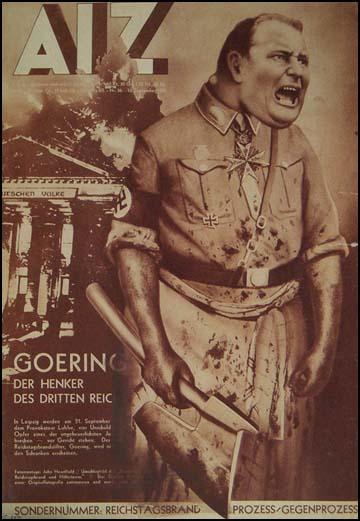
(Copyright The Official John Heartfield Exhibition & Archive)

